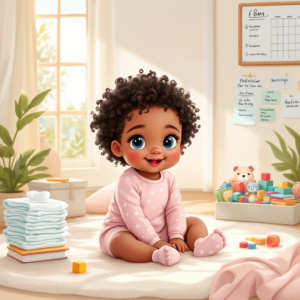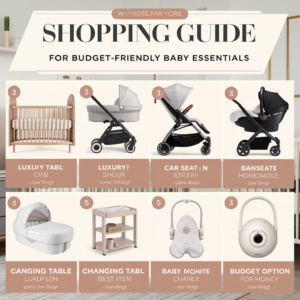A baby girl essentials budget is a strategic financial plan focused on acquiring necessary items for a baby girl while minimizing costs. It involves identifying truly essential items, finding cost-effective purchasing methods, and balancing quality with affordability to ensure the baby’s needs are met without overspending.
Key Takeaways:
- Distinguishing between essential and non-essential items is crucial
- Timing purchases to coincide with sales can lead to significant savings
- Considering second-hand or hand-me-down items can be both economical and eco-friendly
- Bulk buying for certain items can reduce overall costs
- Investing in convertible or multi-use items can provide long-term savings
Understanding Baby Girl Essentials
Baby girl essentials are items considered necessary for the care, comfort, and development of a baby girl. These typically include clothing, feeding supplies, diapering needs, safety items, and basic gear. Understanding what truly qualifies as essential can help parents avoid overspending on unnecessary items.
Step-by-Step Guide to Saving Money on Baby Girl Essentials
1. Create a Prioritized List of Essentials (2-3 months before due date)
- Research what items are truly necessary for a newborn girl
- Differentiate between must-haves and nice-to-haves
- Consult experienced parents or pediatricians for advice
2. Research Average Costs (2 months before due date)
- Compare prices across different retailers
- Look into both online and brick-and-mortar store options
- Consider the cost difference between branded and generic items
3. Plan for Sales and Discounts (Ongoing)
- Sign up for newsletters from baby stores
- Follow social media accounts of baby brands
- Plan major purchases around known sale periods (e.g., Black Friday)
4. Explore Second-Hand Options (1-2 months before due date)
- Check local consignment shops for gently used items
- Join online marketplaces or parent groups for second-hand deals
- Consider hand-me-downs from family and friends
5. Invest in Convertible Items (Before baby arrives)
- Look for cribs that convert to toddler beds
- Consider car seats that adapt as your child grows
- Choose a stroller that can accommodate your child from infancy to toddlerhood
6. Buy in Bulk Strategically (After determining preferred brands)
- Purchase diapers and wipes in larger quantities for better value
- Buy non-perishable items like baby wash or lotion in bulk
- Be cautious with bulk buying clothing, as babies grow quickly
7. Utilize Baby Registries Effectively (2-3 months before due date)
- Register for essential items across different price points
- Take advantage of completion discounts offered by many retailers
- Consider group gifting options for higher-priced items
8. DIY Where Possible (Ongoing)
- Make your own baby food when introducing solids
- Consider cloth diapers as a long-term money-saving option
- Create simple toys or sensory items from household objects
9. Borrow Rarely-Used Items (As needed)
- Ask to borrow items like baby swings or bouncers that are used for a short time
- Join local parent groups that facilitate item sharing
- Consider rental options for short-term use items
10. Shop Off-Season (Ongoing)
- Buy winter clothes in summer and vice versa
- Look for clearance sales at the end of each season
- Purchase holiday-themed items after the holiday has passed
11. Maximize Loyalty Programs and Cashback (Ongoing)
- Sign up for loyalty programs at frequently visited stores
- Use cashback credit cards for major purchases
- Utilize cashback apps when shopping online
12. Review and Adjust Your Strategy (Monthly)
- Keep track of what items you use most frequently
- Reassess your needs as your baby grows
- Be prepared to change brands or strategies if certain items aren’t working out
Innovative Money-Saving Ideas for 2025
- Use AI-powered price prediction tools to time your purchases
- Participate in blockchain-based baby item exchange networks
- Utilize 3D printing for custom baby items at lower costs
- Join virtual co-op buying groups for bulk purchase savings
- Engage with augmented reality apps to “test” items before buying
Essential Categories to Focus On
Feeding:
- Bottles and nipples (if not breastfeeding exclusively)
- Breast pump and storage bags (for breastfeeding mothers)
- Bibs and burp cloths
- High chair (when starting solids)
Diapering:
- Diapers (cloth or disposable)
- Wipes
- Diaper rash cream
- Changing pad
Clothing:
- Onesies and sleepers
- Socks and mittens
- Weather-appropriate outerwear
- Gentle laundry detergent
Sleep:
- Crib or bassinet
- Firm mattress and waterproof cover
- Fitted sheets
- Sleep sacks or swaddles
Health and Safety:
- Baby monitor
- Thermometer
- Nail clippers
- Baby-proofing supplies
Frequently Asked Questions
Q: How much can I expect to save by buying second-hand baby items? A: You can potentially save 50-80% on gently used items compared to buying new.
Q: Is it safe to use second-hand car seats or cribs? A: It’s generally recommended to buy these items new due to safety concerns and potential recalls.
Q: How many clothing items does a newborn baby girl really need? A: Start with 5-7 onesies, 3-5 sleepers, and a few weather-appropriate outfits. Babies grow quickly, so don’t overbuy.
Q: Are expensive baby brands worth the cost? A: Not always. Many generic or less expensive brands offer similar quality at lower prices.
Q: How can I save money on diapers without compromising quality? A: Consider subscribing to diaper delivery services, using store-brand diapers, or exploring cloth diapering options.
Conclusion
Saving money on baby girl essentials requires a combination of strategic planning, smart shopping, and a clear understanding of what your baby truly needs. By prioritizing essential items, taking advantage of sales and second-hand options, and investing in convertible products, you can significantly reduce your expenses without compromising on your baby’s care. Remember, the most valuable things you can give your baby – love, attention, and care – don’t come with a price tag. With careful budgeting and resourceful thinking, you can provide everything your baby girl needs while maintaining financial stability.
Would you like me to continue with the next article in the updated list?



